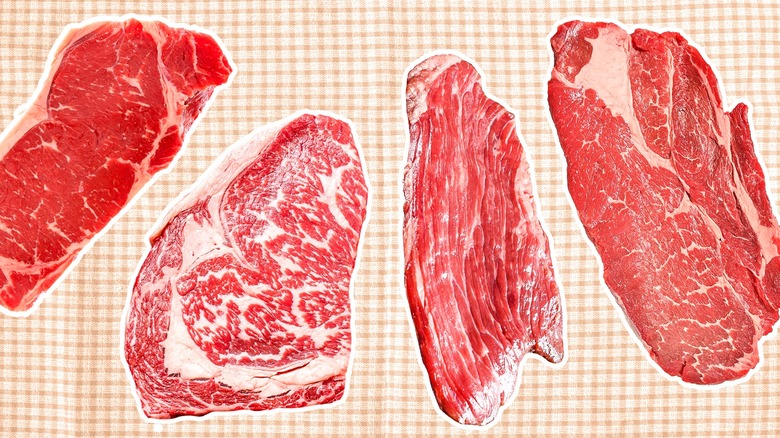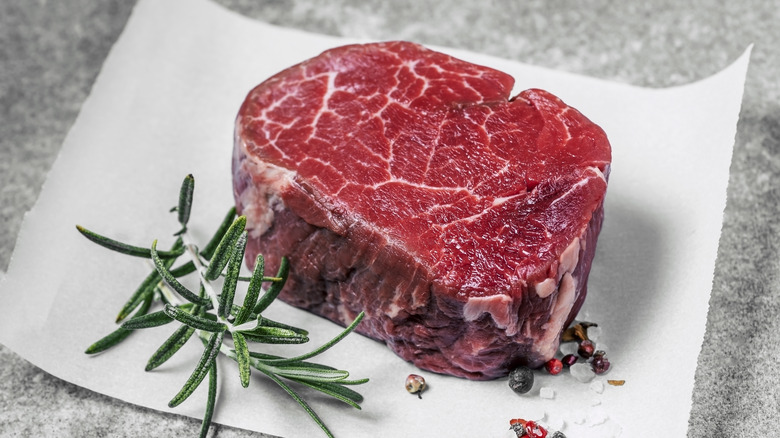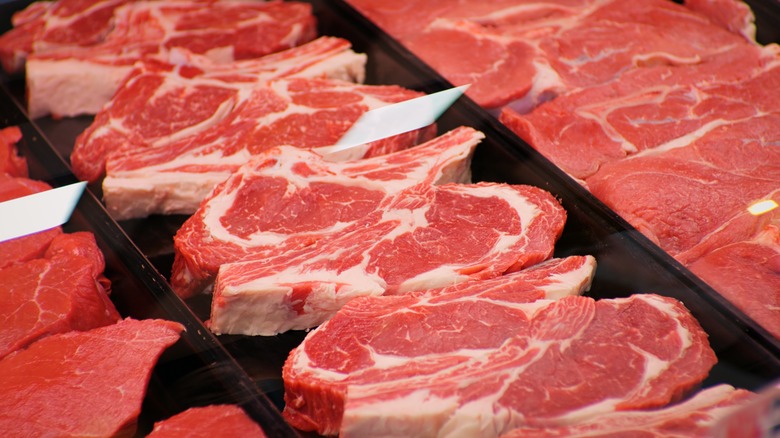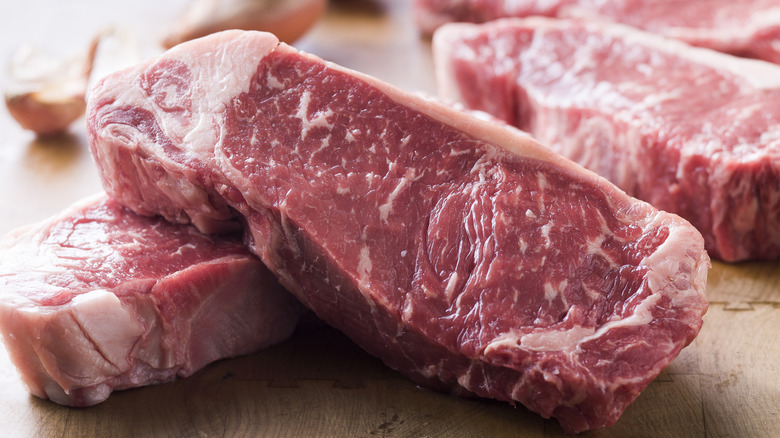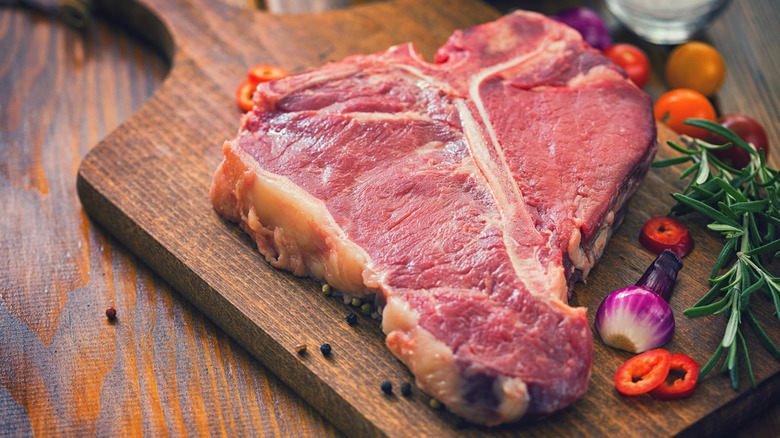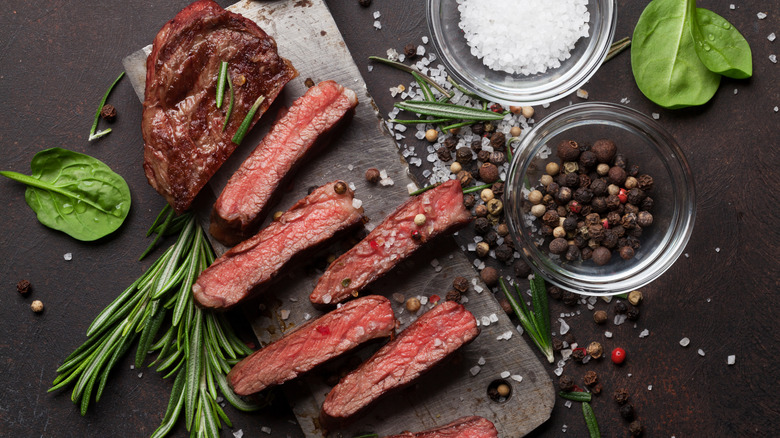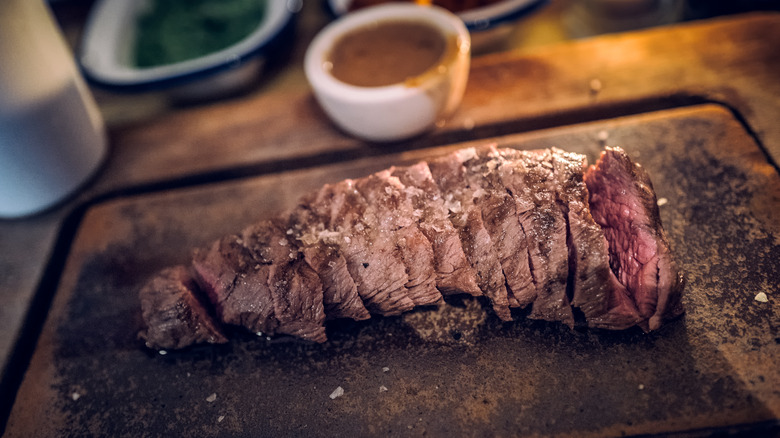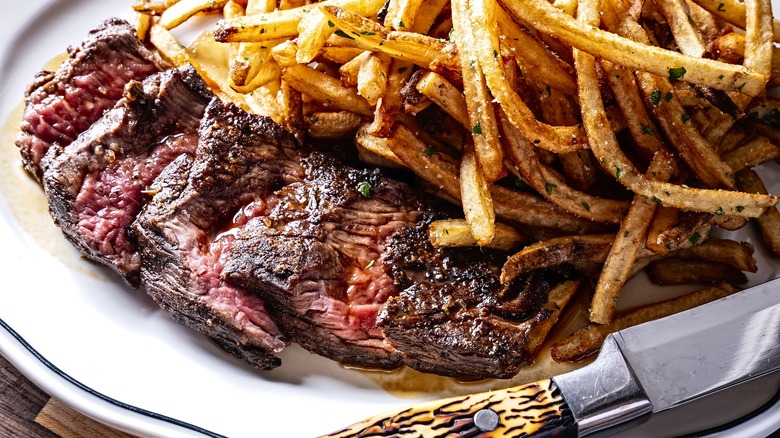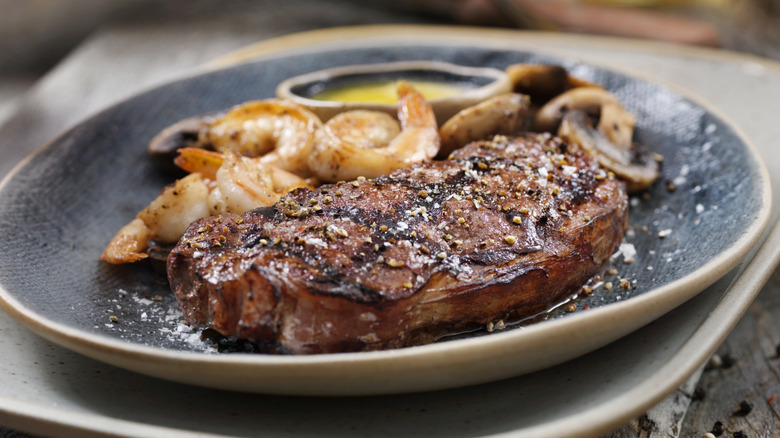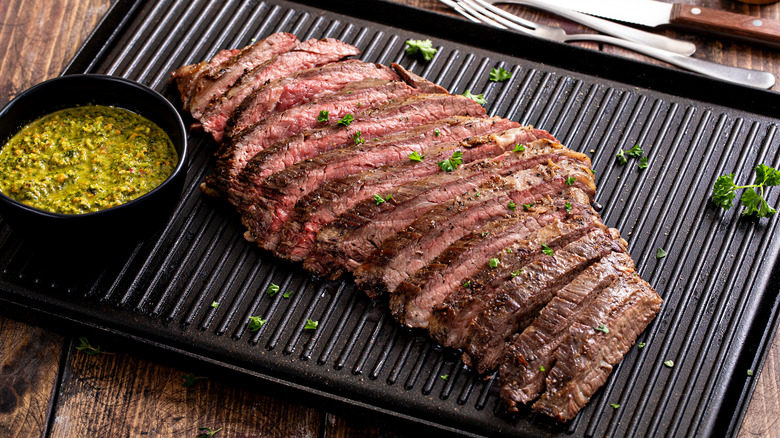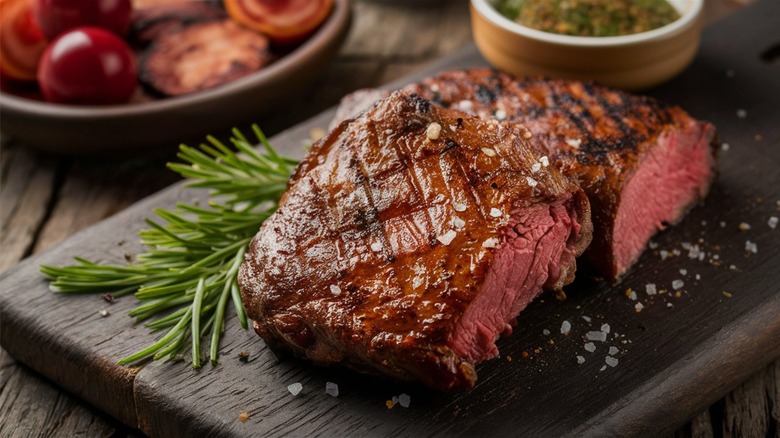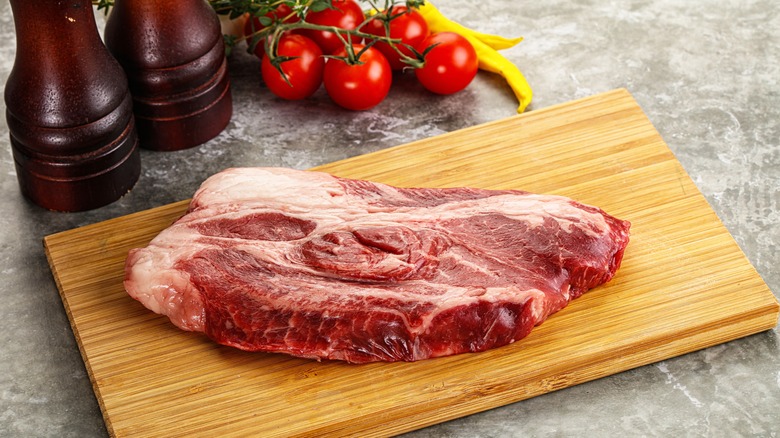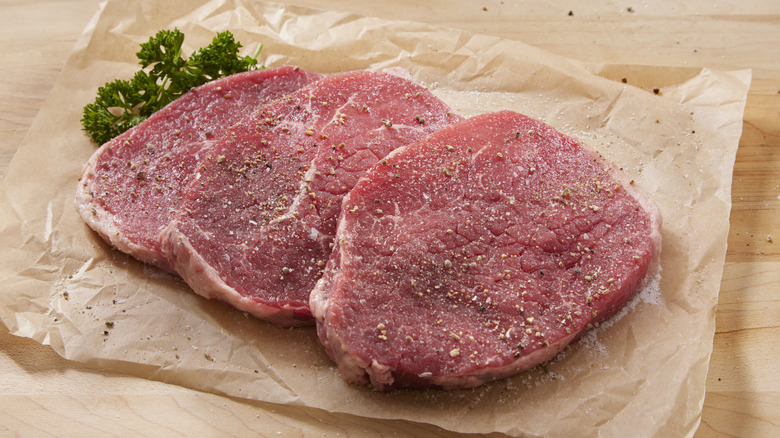Your Guide To Different Cuts Of Steak
We may receive a commission on purchases made from links.
There comes a point in most parents' lives when they realize they can't help their kids with their math homework anymore — because it's more complicated than they remember. Along those lines, you may have felt a similar feeling when standing at the meat counter of your local supermarket or butcher shop. Though you'll likely see the familiar handful of steaks, you may also notice a variety of new cuts cropping up. And it's not your imagination: The beef industry puts a lot of money into finding new cuts of beef that can be marketed successfully to chefs, influencers, and (eventually) home cooks.
Now, while the good news is consumers have never had more options for a high-quality steak, the bad news is that it's never been more confusing, either. Thankfully, as a trained chef and former restauranteur, I can help with that. Not only have I cooked more than my fair share of steaks, but I'm something of a food science geek, too. Consequently, I understand the fundamentals that make one steak tender (and another tough). To learn more about the types of steak you're most likely to see in stores and online, here is your guide to different cuts of steak.
Beef tenderloin
Whether you buy it whole for roasting or in medallions for grilling as a steak, beef tenderloin is a premium-priced prestige cut. It's one of the least-used muscles in the cow's body, which explains its unusually tender texture and minimal connective tissue. It consists of a long, cylindrical muscle that tapers at the ends, with a second strip of beef (the so-called chain muscle) running down one side. The chain can be removed or left on, as you wish. However, the thin membrane that covers part of the tenderloin, called the silverskin, should be removed.
Choosing the best possible tenderloin is important, given its premium price. Look for portions that are reasonably, but not excessively, marbled, and have a fresh, bright-red color. While it's up to you whether you choose to buy a portion with the chain muscle removed (and your steaks will be neater without it), it's a very nice piece of beef in its own right, and almost as tender. In fact, if you buy a whole tenderloin to cut into steaks yourself, separating the chain muscle for another meal is a good way to maximize the value of your beef splurge.
Additionally, tenderloin is usually sold as filet mignon when it's cut for steaks. Properly speaking, this term only refers to pieces cut from the smaller ends of the tenderloin. Whatever you call them, these individual cuts are as tender as a steak can get.
Rib or ribeye
Rib and ribeye steaks are cut from the rib section of the carcass (as you'd expect from the name). While the muscles binding the ribs together are chewy and tough, the muscles running inside the ribs are tender and richly marbled. In fact, rib steaks are the richest and most unctuous of them all.
Now, you'll often see these steaks sold as both rib and ribeye, though not every butcher uses the same name. Some butchers may consider a cut with a bone to be a rib steak, and a ribeye if it doesn't. Others consider it to be a rib steak if the cap muscle is left on, and a ribeye if that's removed. Whichever version you end up buying, it's unquestionably a premium steak (and my personal favorite). If your butcher removes the cap muscle for ribeye steaks, ask to buy some cap steaks. They're also very tender, but a bit leaner, and typically sell for less than the ribeye itself.
The showiest of the rib steaks is a so-called tomahawk or cowboy cut steak. These are thick-cut rib steaks, typically around 2 inches thick, and with the rib bone left long. Some butchers leave all the meat on the bone, while others bare the bone for the sake of a more dramatic appearance. This same cut is sometimes also called a Delmonico steak, if the rib is cut shorter instead of remaining its natural size.
Strip steak
Strip steaks are another top-tier grilling option. These come from the animal's loin — a long muscle that runs along either side of the backbone — and you'll commonly see them sold as striploin, New York strips, and sometimes shell steak. This is a classic steakhouse cut, which you can buy either boneless or bone-in (as you prefer).
A good strip steak isn't quite as tender as filet mignon or rib steak, but that's not necessarily a bad thing. That little extra bit of chew actually enhances the pleasure of eating a good steak. It has a bigger, beefier flavor than the tenderloin, and it's not as rich and fatty as a rib steak. For a lot of steak aficionados, it marks that sweet spot where marbling, tenderness, and flavor are perfectly balanced.
Grilling is usually the first cooking method that comes to mind when you think about a premium steak, but some chefs argue that a screaming-hot cast iron skillet — like the Lodge cast iron skillet available through Amazon — may be the best strip steak option for a home cook. It gives the steaks a beautifully seared crust, one you can't match on the grill. Ina Garten's go-to method involves searing the steak on a hot grill, then moving it to a cooler part to finish cooking. Personally, I favor the opposite technique, known as reverse sear: cook the steak low and slow at first, and then give it a hard sear at the end.
Porterhouse and T-bone
Tenderloin and strip steak are both premium grilling options that command a high price to match, but they could hardly be more different. Of course, if you can't decide between the two, well ... that's when you opt for a porterhouse or a T-bone.
The strip and the tenderloin occur above and below the signature T-shaped bone that runs alongside the animal's spine. The strip is above and the tenderloin below — meaning you get some of each with a porterhouse or T-bone. The porterhouse comes from further forward along the loin and contains a larger piece of tenderloin, while the T-bone comes from the back of the loin and has a smaller piece of tenderloin. At the very rear is the so-called wing steak, which is mostly a bone-in striploin that still has a small mouthful of tenderloin attached.
The porterhouse is a larger steak, typically weighing 1 ½ to 2 pounds. It can feed up to four people, depending on your appetites. For a really showstopping meal, Bobby Flay's technique for meat involves basting it with butter, broiling it, then slicing and reassembling it on the cutting board or a serving tray (which is hard to top). It's best to grill or broil a porterhouse or T-bone, because the bone makes it difficult to sear one properly in a skillet. That's not usually a deal-breaker, but it's something to know before you buy a T-bone.
Denver and chuck eye steaks
Most of us have likely eaten plenty of chuck over the years. It's a tough cut from the animal's shoulder, and it's usually braised or slow cooked to a pot roast consistency. You may be surprised, then, to see two cuts from it listed among the more premium steak varieties. But there's good reason for them to be here: the Denver and chuck eye steaks are both tender (and relatively newer) cuts.
The chuck is made up of several muscles that get differing amounts of use. Some of them, as a result, are surprisingly tender. The Denver steak, for example, is cut from immediately beneath the shoulder blade. It's a complicated cut to fabricate, so don't look for it at your supermarket. You'll need to sweet-talk a butcher or buy them frozen from an online specialty retailer. But what you'll get for your trouble is a flat, more or less rectangular cut that's best when grilled or broiled, then sliced across the grain.
The chuck eye is entirely different. It's a part of the same muscle that you find on rib steaks, but it extends forward into the animal's shoulder (like the capicola on a hog). It's very much like a rib steak, tender and well-marbled, but at a more attractive price, making it a great alternative to its better-known sibling. It's less complicated for meatcutters to extract from the chuck, so you'll occasionally find these at the meat counters of good supermarkets.
Flatiron steak
The flatiron steak is another cut taken from the otherwise-unexceptional shoulder chuck. You could think of it as the yin to a Denver steak's yang, cut from the top of the shoulder blade rather than the bottom. Like the Denver steak, it's a flat, usually triangular cut (hence the name), but sometimes trimmed into a rectangular shape for a neater appearance.
The flatiron is often classed as a marinating steak because it's tough and chewy if not handled correctly. In truth, though, that's an incorrect assumption for a couple of reasons. First, marinades don't actually do much to tenderize a tough cut, since they barely penetrate the meat unless you tenderize it first with a meat mallet (like the mallet from KitchenAid), which makes all the difference in the world. Additionally, you don't want to cook a flatiron steak the same way you would cook a T-bone or a strip.
Instead, sear the whole flatiron to your preferred level of doneness (medium rare is ideal for this kind of steak). Once it's grilled, broiled, or pan-seared (whichever is your preference), slice the steak thinly across the grain. When it's grilled and served this way, a flatiron steak is pleasantly chewy and packs a big, bold, beefy flavor. It's worth the effort you'll invest in finding them.
Bistro steaks (hanger, skirt, flap)
Hanger, skirt, and flap steaks are all relatively obscure cuts, but they've all had a moment in the sun over recent years. Collectively, they're referred to as "bistro" steaks, because frugal French chefs at blue-collar eateries love a bargain cut. Flap steak, known as a "bavette" in France, is the most iconic example of the style. You may also see them referred to as butcher steaks, because in days gone by, they were the kind of cut that butchers would keep for themselves.
Thanks to modern beef marketing, each of these cuts is reasonably available at 21st century butcher shops, online specialty retailers, and even some of the better supermarkets. They'll never be plentiful, because you only get one or two of these steak cuts per carcass, but they're worth seeking out. Like flatiron or flank steak, they have long, chewy muscle fibers, so the trick is to slice them thinly across the grain once they're cooked.
You'll often see steaks like these used in fajitas and tacos, where their flavor will shine (and thin-sliced beef is expected). French bistros often favor the flap for a classic steak frites, which is simply a nicely seared portion of steak served with good fries. As long as you know to slice them thinly across the grain, rather than into square pieces (as you would with a conventional steak), each of these are really enjoyable cuts.
Top sirloin
As you move toward the rear section of a cow, the tender, tasty loin gives way to the relatively tough rump or round cuts in the hip. In between the transition area between the loin and the hip, though, you'll find the sirloin.
Sirloin, in general, is viewed as a nice value cut — representing a fine compromise between pricey but tender premium cuts, and the less-desirable, tougher cuts from the round. Top sirloin is the best of the sirloin cuts, though the name itself refers to its physical location rather than its comparative quality. A top sirloin steak is tender enough to simply grill or pan sear, and has plenty of good, beefy flavor. I'm always happy to find top sirloin on sale, because I think it offers a lot of bang for the buck.
Most of the more premium steaks are much fattier than top sirloin, so it's arguably the best cut for anyone who prefers a lean steak, or wants to indulge occasionally without taking on a whole lot of additional fat. Brazil's popular and trendy picanha, or sirloin cap, steak comes from this area, as well.
Flank steak
Flank steak is another example of a marinating steak, but it's significantly larger than the flatiron, Denver, or any one of the bistro steaks. It's a big slab cut from the steer's abdominal muscles, which means it's more widely available than those smaller offerings. There's plenty of scope for supermarkets to cut a full flank steak into numerous family-sized portions, and you can get a lot of flank steaks from each animal.
When I was a younger man (many years ago), flank steak was my go-to purchase at the meat counter because of its low cost and big flavor. Though it's certainly become more costly over time, it's still a good value compared to top-tier steaks.
Flank is quite lean and has the same kind of long, dense muscle fibers that we've talked about with flatiron and bistro steaks. The best way to cook it is by grilling or broiling it to medium rare, which is hot enough to help the connective tissues start to break down. Then, it's sliced thinly across the grain, leaving it nice and chewy. It's one of several cuts to be served this way (as London broil), and you'll be hard-pressed to find a more flavorful piece of beef.
Bottom sirloin
Like top sirloin, bottom sirloin comes from the area where the steer's loin gives way to tougher cuts from around the hip. Bottom sirloin isn't as tender as top sirloin generally, so it's often cut into strips for stir frying or cubed for stew meat. As a rule, if your supermarket's label just says "sirloin" as opposed to "top sirloin," this is what you're likely getting.
Bottom sirloin is lean and relatively chewy. Though it's best suited to slow cooking methods like braising and stewing, there's still a lot of good, beefy flavor. If you put in the effort to cook this cut of steak appropriately, you'll see a good return on your investment.
An exception to the slow cooking rule for this cut is the tri-tip, which comes from a lesser-used muscle within the larger bottom sirloin group. Tri-tip is a tender cut hiding within a group of tougher ones (similar to those cuts from the chuck that I've already discussed). It's roughly triangular in shape, full of flavor, and usually inexpensive compared to premium cuts like a ribeye. It's a great value cut, and California's signature steak for grilling.
Chuck or blade steak
With a few exceptions, steaks from chuck are tough, and filled with fat and gristle. You likely know them as chuck steaks, blade steaks, or perhaps 7-bone steaks, and they're some of the lowest-priced cuts you can buy because of their limitations. Yet despite their toughness, there's a lot to like about chuck steaks. They're well-marbled, and can pack a lot of big, beefy flavor. Even their gristle and connective tissue can be positives because they soften under long, slow cooking, and make the beef rich and lush.
Surprisingly, you can enjoy a grilled chuck steak if you aren't hung up on eating beef rare or medium rare. Cook chuck steaks to medium instead — the point where the connective tissue starts to melt, but the steak isn't cooked to the point of becoming dry. It'll still be somewhat chewy, but in a good way (like a lobster tail).
Chuck is also a great steak cut to cook sous vide. Some enthusiasts may think of sous vide merely as a way to get a perfectly medium rare ribeye or strip steak, but it's more than that. If you leave a tough cut like chuck in the sous vide bath for long enough, it becomes just as tender as a higher end steak. All you need to do is give it a good sear at the end, and you've got an enviably flavorful, well-marbled steak at a bargain price. Frankly, these steak cuts are a great budget-stretcher.
Rump or round steak
Like the shoulder, the animal's hip is filled with well-used muscles. Consequently, these cuts, usually sold as rump or round, are chewy and packed with dense muscle fibers. They work very well as roasts, because their tight texture means they can be sliced beautifully thin for sandwiches. However, as steaks, they're more limited.
Whether cut for steaks or roasts, you'll typically see these sold as top round, bottom round, and eye of round (from the inside, outside, and middle of the leg, respectively). Top round is the best of the three, at least as a steak. It's more tender and flavorful than the others, though it's still considered a marinating steak that's best suited for slow cooking or cutting into thin strips. Eye of round and bottom round are tougher, and less beefy-tasting. All three are sometimes mechanically tenderized and sold in supermarkets as thin (and cleverly named) cube steaks, which are suitable for pan searing and making Swiss steak or chicken-fried steak.
Round steaks still have their positives. Like sirloin, they're lean, and therefore lower in fat. Because of their leanness and relatively large size (those are big muscles), they make great jerky, too — something I've often done with round steaks. They also tenderize pretty well through various methods, and can be a good value for your dollar. You won't mistake them for a more premium steak, by any means, but they're useful in a lot of recipes.
